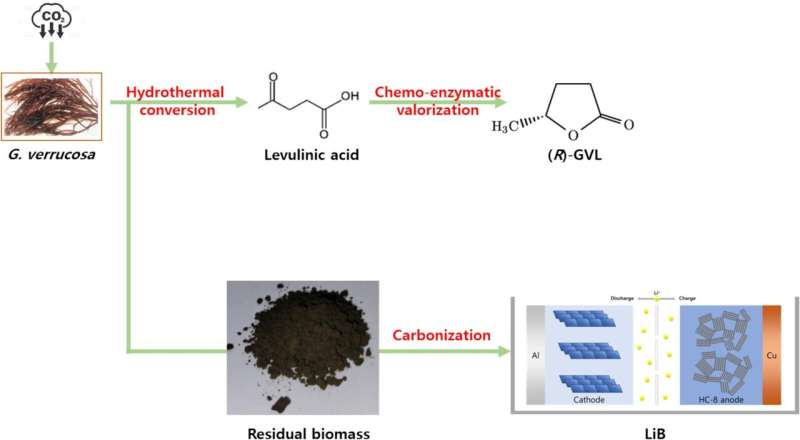A new technology has been developed to convert common seaweeds such as Kkosiraegi, which are often used in cooking, into high-quality sources for both bio-aviation fuels and energy storage devices. The results were published in the Chemical Engineering Journal.
Dr. Kyoungseon Min’s research team at the Gwangju Clean Energy Energy Research Center of the Korea Institute of Energy Research, in collaboration with Kangwon National University, has developed a process to produce enantioselective bio-aviation fuel precursors [(R)-gamma-valerolactone] from seaweed. The residual biomass from this production process can also be used as anode materials for lithium-ion batteries.
The utilization of marine biomass, like seaweed, in biorefineries can lead to the production of fuels and chemicals, replacing the need for traditional petroleum-based chemical production. Recently, seaweed has gained attention as a raw material for bio-aviation fuel, as applying bio-aviation fuel can reduce greenhouse gas emissions by up to 82% compared to conventional aviation fuel. As a result, the eco-friendly bio-aviation fuel market is expected to account for 35% of the total aviation fuel market by 2070.
Among the commercialized bio-aviation fuel production processes, the method with the greatest greenhouse gas reduction effect is the sugar-to-jet technology. Through a pre-treatment process, biomass is converted into fermentable sugars, which are utilized as a carbon source for microbial fermentation to produce the precursors necessary for bio-aviation fuel production.
However, the pre-treatment process is complex, and the reactions require high-pressure hydrogen, making the process costly. Additionally, the amount of precursor produced through this process is only about 15% of the fermentable sugars used, indicating a need for overall improvement in efficiency.
To address these challenges, the research team developed a levulinic acid-based process that generates precursors through a one-step enzymatic reaction instead of microbial fermentation. Using this process, seaweed can be converted into levulinic acid with simple acid treatment, and through an enzymatic reaction, it produces (R)-gamma-valerolactone [(R)-GVL], which has more value-added utility than traditional precursors.
The key to this process is directly converting levulinic acid into a precursor through an enzymatic reaction. Seaweeds like Kkosiraegi are converted into levulinic acid with just an acid treatment. Then, using an engineered enzyme developed by the research team, the precursor (R)-GVL is produced. Unlike conventional processes that require microbial fermentation of biomass, this method only relies on an enzymatic reaction, allowing for the production of 10 times more precursor from the same amount of biomass.
Optically pure (R)-GVL can be used not only for bio-aviation fuel but also as an intermediate for biopharmaceuticals, such as hypertension treatments. However, for it to be used in hypertension medications, it is necessary to selectively produce only the (R)-GVL form.
Typical Ru-based catalysts convert biomass to GVL as a mixture of (R)- and (S)-forms (optical isomers), but the mixture has limitation for value-added applications such as bioplastics and biopharmaceuticals, making enantioselective production important.
The enzyme engineered by the research team can convert levulinic acid into (R)-GVL with over 99.999% accuracy. Until now, the lack of technology to selectively produce (R)-GVL has prevented its application in the biopharmaceutical field. However, this new technological development marks a turning point, enabling its future use in such applications.
Additionally, the leftover Kkosiraegi residue after levulinic acid production was utilized as an anode material for lithium-ion batteries through a carbonization process. The research team prepared “hard carbon,” an anode material for lithium-ion batteries, from the carbonized Kkosiraegi residue. They applied this material to lithium-ion batteries and analyzed its capacity, output, and lifespan characteristics, confirming its potential for practical application.
Dr. Kyoungseon Min, the lead researcher, stated, “With Korea being surrounded by the sea on three sides, we are in a geopolitically advantageous position for securing seaweed.”
She added, “This technology not only develops a process to produce value-added materials from seaweed applicable to diverse industrial sectors but also utilizes the remaining biomass as electrode material. This can make a significant contribution to accelerating the realization of carbon neutrality.”
More information:
Jaehyun Cha et al, Algal biomass-based zero-waste biorefinery for producing optically pure (R)-γ-valerolactone and carbonaceous electrodes applicable for energy storage devices, Chemical Engineering Journal (2024). DOI: 10.1016/j.cej.2024.151713
Citation:
Transforming seaweeds into raw materials for aviation fuel and pharmaceuticals (2024, September 30)
retrieved 30 September 2024
from https://phys.org/news/2024-09-seaweeds-raw-materials-aviation-fuel.html
This document is subject to copyright. Apart from any fair dealing for the purpose of private study or research, no
part may be reproduced without the written permission. The content is provided for information purposes only.

